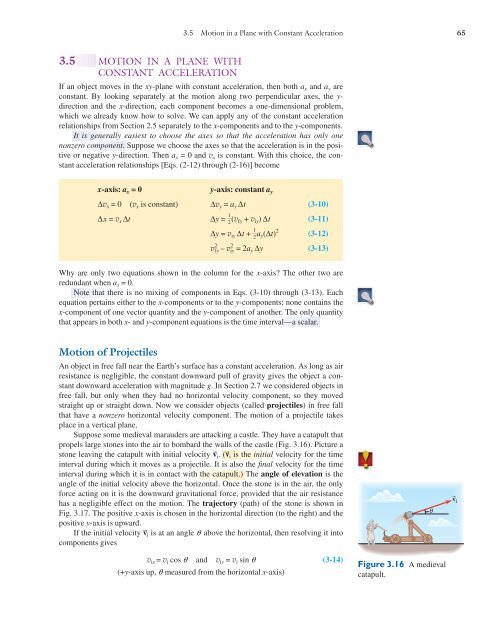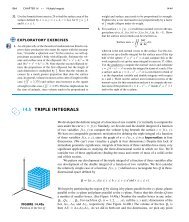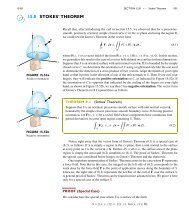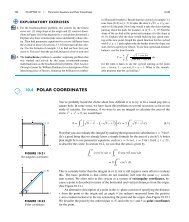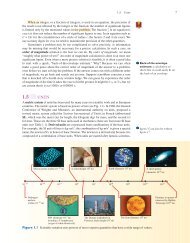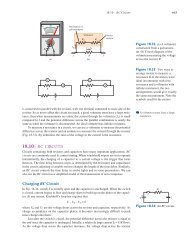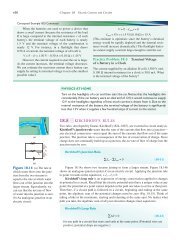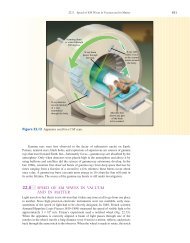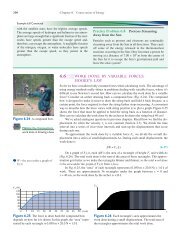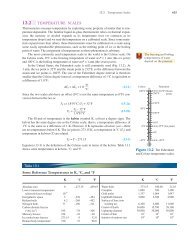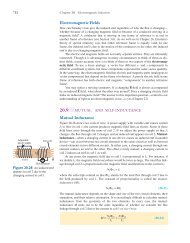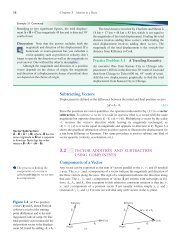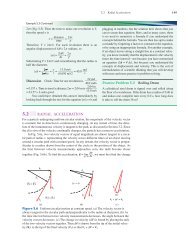Motion of Projectiles
Motion of Projectiles
Motion of Projectiles
Create successful ePaper yourself
Turn your PDF publications into a flip-book with our unique Google optimized e-Paper software.
3.5 <strong>Motion</strong> in a Plane with Constant Acceleration 65<br />
3.5 MOTION IN A PLANE WITH<br />
CONSTANT ACCELERATION<br />
If an object moves in the xy-plane with constant acceleration, then both a x and a y are<br />
constant. By looking separately at the motion along two perpendicular axes, the y-<br />
direction and the x-direction, each component becomes a one-dimensional problem,<br />
which we already know how to solve. We can apply any <strong>of</strong> the constant acceleration<br />
relationships from Section 2.5 separately to the x-components and to the y-components.<br />
It is generally easiest to choose the axes so that the acceleration has only one<br />
nonzero component. Suppose we choose the axes so that the acceleration is in the positive<br />
or negative y-direction. Then a x = 0 and v x is constant. With this choice, the constant<br />
acceleration relationships [Eqs. (2-12) through (2-16)] become<br />
x-axis: a x = 0<br />
y-axis: constant a y<br />
∆v x = 0 (v x is constant) ∆v y = a y ∆t (3-10)<br />
∆x = v x ∆t ∆y = 1 2 (v fy + v iy ) ∆t (3-11)<br />
∆y = v iy ∆t + 1 2 a y (∆t) 2 (3-12)<br />
vfy 2 – viy 2 = 2a y ∆y (3-13)<br />
Why are only two equations shown in the column for the x-axis? The other two are<br />
redundant when a x = 0.<br />
Note that there is no mixing <strong>of</strong> components in Eqs. (3-10) through (3-13). Each<br />
equation pertains either to the x-components or to the y-components; none contains the<br />
x-component <strong>of</strong> one vector quantity and the y-component <strong>of</strong> another. The only quantity<br />
that appears in both x- and y-component equations is the time interval—a scalar.<br />
<strong>Motion</strong> <strong>of</strong> <strong>Projectiles</strong><br />
An object in free fall near the Earth’s surface has a constant acceleration. As long as air<br />
resistance is negligible, the constant downward pull <strong>of</strong> gravity gives the object a constant<br />
downward acceleration with magnitude g. In Section 2.7 we considered objects in<br />
free fall, but only when they had no horizontal velocity component, so they moved<br />
straight up or straight down. Now we consider objects (called projectiles) in free fall<br />
that have a nonzero horizontal velocity component. The motion <strong>of</strong> a projectile takes<br />
place in a vertical plane.<br />
Suppose some medieval marauders are attacking a castle. They have a catapult that<br />
propels large stones into the air to bombard the walls <strong>of</strong> the castle (Fig. 3.16). Picture a<br />
stone leaving the catapult with initial velocity v i . (v i is the initial velocity for the time<br />
interval during which it moves as a projectile. It is also the final velocity for the time<br />
interval during which it is in contact with the catapult.) The angle <strong>of</strong> elevation is the<br />
angle <strong>of</strong> the initial velocity above the horizontal. Once the stone is in the air, the only<br />
force acting on it is the downward gravitational force, provided that the air resistance<br />
has a negligible effect on the motion. The trajectory (path) <strong>of</strong> the stone is shown in<br />
Fig. 3.17. The positive x-axis is chosen in the horizontal direction (to the right) and the<br />
positive y-axis is upward.<br />
If the initial velocity v i is at an angle q above the horizontal, then resolving it into<br />
components gives<br />
v ix = v i cos q and v iy = v i sin q (3-14)<br />
(+y-axis up, q measured from the horizontal x-axis)<br />
Figure 3.16 A medieval<br />
catapult.<br />
θ<br />
v i
66 Chapter 3 <strong>Motion</strong> in a Plane<br />
y<br />
v y<br />
v y<br />
v y = 0<br />
Figure 3.17 <strong>Motion</strong> diagram<br />
showing the trajectory <strong>of</strong> a projectile.<br />
The position is drawn at equal<br />
time intervals. Superimposed are<br />
the velocity vectors along with<br />
their x- and y-components.<br />
v iy<br />
v ix<br />
v<br />
v ix ix<br />
v v y ix<br />
v ix<br />
θ<br />
v y<br />
v ix<br />
v ix<br />
v fy<br />
x<br />
The horizontal and vertical<br />
motions <strong>of</strong> a projectile can be<br />
treated separately; they are<br />
independent <strong>of</strong> each other.<br />
With the y-axis pointing up, a y = –g because the acceleration is downward (in the –y<br />
direction). The acceleration has no x-component (a x = 0), so the stone’s horizontal velocity<br />
component v x is constant. The vertical velocity component v y changes at a constant<br />
rate, exactly as if the stone were propelled straight up with an initial speed <strong>of</strong> v iy . The initially<br />
positive v y decreases until, at the top <strong>of</strong> flight, v y = 0. Then the pull <strong>of</strong> gravity makes<br />
the projectile fall back downward. During the downward trip, v y is still changing at the<br />
same constant rate with which it changed on the way up and at the top <strong>of</strong> the path. The<br />
acceleration has the same constant value—magnitude and direction—for the entire path.<br />
The displacement <strong>of</strong> the projectile at any instant is the vector sum <strong>of</strong> the displacements<br />
in the two mutually perpendicular directions. The motion <strong>of</strong> a projectile when air<br />
resistance is negligible is the superposition <strong>of</strong> horizontal motion with constant velocity<br />
and vertical motion with constant acceleration. The vertical and horizontal motions<br />
each proceed independently, as if the other motion were not present. In the experiment<br />
<strong>of</strong> Fig. 3.18, one ball was dropped and, at the same instant, another was projected horizontally.<br />
The strobe photo shows snapshots <strong>of</strong> the two balls at equally spaced time intervals.<br />
The vertical motion <strong>of</strong> the two is identical; at every instant, the two are at the same<br />
height. The fact that they have different horizontal motion does not affect their vertical<br />
motion. (This statement would not be true if air resistance were significant.)<br />
Figure 3.18 Independence <strong>of</strong><br />
horizontal and vertical motion <strong>of</strong><br />
a projectile in the absence <strong>of</strong> air<br />
resistance. The vertical motion<br />
<strong>of</strong> the projectile (white) is the<br />
same as that <strong>of</strong> an object (red)<br />
that falls straight down.<br />
PHYSICS AT HOME<br />
Take a nickel and a penny to a room with a high table or countertop. Place the<br />
penny at the edge <strong>of</strong> the table and then slide the nickel so it collides with the penny.<br />
Listen for the sound <strong>of</strong> the two coins hitting the floor. The two coins will slide <strong>of</strong>f<br />
the table with different horizontal velocities but will land at the same time.
3.5 <strong>Motion</strong> in a Plane with Constant Acceleration 67<br />
Conceptual Example 3.4<br />
Trajectory <strong>of</strong> a Projectile<br />
The graph <strong>of</strong> an equation <strong>of</strong> the form<br />
y = kx 2 , k = a nonzero constant<br />
is a parabola. Show that the trajectory <strong>of</strong> a projectile is a<br />
parabola. [Hint: Choose the origin at the highest point <strong>of</strong><br />
the trajectory and let t i = 0 at that instant.]<br />
Strategy and Solution We start at the high point <strong>of</strong><br />
the path and look at displacements from there. The horizontal<br />
displacement is proportional to the elapsed time t<br />
since the horizontal velocity is constant. The vertical displacement<br />
is the average vertical velocity component<br />
times the elapsed time t. The average vertical velocity<br />
component is itself proportional to t since it changes at a<br />
constant rate. Therefore, the vertical displacement is proportional<br />
to t 2 . Thus, the vertical displacement y is proportional<br />
to the square <strong>of</strong> the horizontal displacement x<br />
and y = kx 2 , where k is a constant <strong>of</strong> proportionality. The<br />
path followed by a projectile in free fall is a parabola.<br />
Discussion The same conclusion can be drawn algebraically.<br />
With the +y-axis upward and the origin and t = 0<br />
at the top <strong>of</strong> flight, x i , y i , and v iy are all zero. Then x = v ix t<br />
and<br />
y = v iy t + 1 2 a yt 2 = – 1 2 gt 2 = – 1 2 x g<br />
g v<br />
<br />
x 2<br />
2<br />
<br />
ix = –<br />
2v<br />
So y is proportional to x 2 and the constant <strong>of</strong> proportionality<br />
is –g/(2v 2 ix).<br />
Conceptual Practice Problem 3.4<br />
Stones<br />
2<br />
ix<br />
Throwing<br />
You stand at the edge <strong>of</strong> a cliff and throw stones horizontally<br />
into the river below. To double the horizontal displacement<br />
<strong>of</strong> a stone from the cliff to where it lands, by<br />
what factor must you increase the stone’s initial speed?<br />
Neglect air resistance.<br />
Figure 3.19 shows graphs <strong>of</strong> the x- and y-components <strong>of</strong> the velocity and position <strong>of</strong><br />
a projectile as functions <strong>of</strong> time. In this case, the projectile is launched above flat ground<br />
at t = 0 and returns to the same elevation at a later time t f . Note that the y-component<br />
graphs are symmetrical about the vertical line through the highest point in the trajectory.<br />
The y-component <strong>of</strong> velocity decreases linearly from its initial value; the slope <strong>of</strong> the line<br />
is a y = –g. When v y = 0, the projectile is at the apex <strong>of</strong> its trajectory. Then v y continues to<br />
decrease at the same rate and is now negative with its magnitude getting larger and larger.<br />
At t f , when the projectile has returned to its original altitude, the y-component <strong>of</strong> the<br />
velocity has the same magnitude as at t = 0 but with the opposite sign (v y = –v iy ).<br />
The graph <strong>of</strong> y(t) indicates that the projectile moves upward, quickly at first and<br />
then gradually slowing, until it reaches the maximum height. The slope <strong>of</strong> the tangent to<br />
the y(t) graph at any particular moment <strong>of</strong> time is v y at that instant. At the highest point<br />
<strong>of</strong> the y(t) graph, the tangent is horizontal and v y = 0. After that, gravity makes the projectile<br />
start to fall downward.<br />
The horizontal velocity is constant, so the graph <strong>of</strong> v x (t) is a horizontal line. The horizontal<br />
position x increases uniformly in time because the object is moving with a constant v x .<br />
Vertical velocity v y<br />
v iy<br />
0<br />
v fy<br />
0<br />
1<br />
–<br />
2t f<br />
t f<br />
Time<br />
Horizontal velocity v x<br />
v ix<br />
0<br />
0<br />
1<br />
–<br />
2t f<br />
t f<br />
Time<br />
Vertical position y<br />
0<br />
0<br />
1<br />
–<br />
2t f<br />
t f<br />
Time<br />
Horizontal position x<br />
0<br />
0<br />
1<br />
–<br />
2t f<br />
t f<br />
Time<br />
Figure 3.19 Projectile<br />
motion: separate vertical and<br />
horizontal quantities versus time.
68 Chapter 3 <strong>Motion</strong> in a Plane<br />
Example 3.5<br />
Attacking the Castle Walls<br />
The catapult used by the marauders hurls a stone<br />
with a velocity <strong>of</strong> 50.0 m/s at a 30.0° angle <strong>of</strong> elevation<br />
(Fig. 3.20). (a) What is the maximum height<br />
reached by the stone? (b) What is its range (defined as<br />
the horizontal distance traveled when the stone returns to<br />
its original height)? (c) How long has the stone been in<br />
the air when it returns to its original height?<br />
Strategy The problem gives both the magnitude and<br />
direction <strong>of</strong> the initial velocity <strong>of</strong> the stone. Ignoring air<br />
resistance, the stone has a constant downward acceleration<br />
once it has been launched—until it hits the ground or<br />
some obstacle. We choose the positive y-axis upward and<br />
the positive x-axis in the direction <strong>of</strong> horizontal motion <strong>of</strong><br />
the stone (toward the castle). When the stone reaches its<br />
maximum height, the velocity component in the y-<br />
direction is zero since the stone goes no higher. When the<br />
stone returns to its original height, ∆y = 0 and v y = –v iy .<br />
The range can be found once the time <strong>of</strong> flight t f is<br />
known—time is the quantity that connects the x-<br />
component equations to the y-component equations.<br />
Therefore, we solve (c) before (b). One way to find t f is to<br />
find the time to reach maximum height and then double it<br />
(see Fig. 3.19). (Other methods include setting ∆y = 0 or<br />
setting v y = –v iy .)<br />
Solution (a) First we find the x- and y-components <strong>of</strong><br />
the initial velocity for an angle <strong>of</strong> elevation q = 30.0°.<br />
v iy = v i sin q and v ix = v i cos q<br />
The maximum height is the vertical displacement ∆y<br />
when v fy = 0.<br />
∆y = 1 2 (v fy + v iy ) ∆t = 1 2 (0 + v i sin q) ∆t<br />
Eliminating the time interval using v fy – v iy = a y ∆t yields<br />
∆y = 1 2 (v i sin q) 0–v a i sin q<br />
<br />
y <br />
= – (v i sin<br />
q) 2<br />
<br />
2ay<br />
–(50.0 m/s × sin 30.0°) 2<br />
= = 31.9 m<br />
2 × (–9.80 m/s 2 )<br />
The maximum height <strong>of</strong> the projectile is 31.9 m above its<br />
launch height.<br />
(c) The time <strong>of</strong> flight (t f ) is twice the time it takes the projectile<br />
to reach its maximum height. The time to reach the<br />
maximum height can be found from<br />
v fy = 0 = v iy + a y ∆t<br />
Solving for ∆t,<br />
∆t = – viy<br />
a<br />
<br />
y<br />
The time <strong>of</strong> flight is<br />
–50.0 m/s × sin 30.0°<br />
t f = 2 ∆t = 2 × = 5.10 s<br />
–9.80 m/s 2<br />
(b) The range is<br />
∆x = v ix t f = (50.0 m/s × cos 30.0°) × 5.10 s = 221 m<br />
Discussion<br />
Quick check: using<br />
y f – y i = v iy ∆t + 1 2 a y (∆t) 2<br />
we can check that ∆y = 31.9 m when ∆t = 1 2 × 5.10 s and<br />
that ∆y = 0 when ∆t = 5.10 s. Here we check the first <strong>of</strong><br />
these:<br />
∆y = (50.0 m/s × sin 30.0°) × 2.55 s + 1 2 × (–9.80 m/s 2 ) × (2.55 s) 2<br />
= 63.8 m + (–31.9 m) = 31.9 m<br />
v ix<br />
v iy<br />
v i<br />
Maximum<br />
height<br />
30.0°<br />
Initial launch height<br />
Range<br />
Figure 3.20<br />
A catapult projects a stone into the air in an attack on a castle wall.<br />
Continued on next page
3.5 <strong>Motion</strong> in a Plane with Constant Acceleration 69<br />
Example 3.5 Continued<br />
which is correct. This is not an independent check, since<br />
this equation can be derived from the others, but it can<br />
reveal algebra or calculation errors.<br />
Since we analyze the horizontal motion independently<br />
from the vertical motion, we start by resolving the<br />
given initial velocity into x- and y-components. Time is<br />
what connects the horizontal and vertical motions.<br />
Practice Problem 3.5<br />
for Arrows<br />
Maximum Height<br />
Archers have joined in the attack on the castle and are<br />
shooting arrows over the walls. If the angle <strong>of</strong> elevation<br />
for an arrow is 45°, find an expression for the maximum<br />
height <strong>of</strong> the arrow in terms <strong>of</strong> v i and g. [Hint: Simplify<br />
the expression using sin 45° = cos 45° = 1/2.]<br />
PHYSICS AT HOME<br />
On a warm day, take a garden hose and aim the nozzle so that the water streams<br />
upward at an angle above the horizontal. Set the nozzle for a fast, narrow stream for<br />
best effect. Once the water leaves the nozzle, it becomes a projectile subject only to<br />
the force <strong>of</strong> gravity (neglecting the small effect <strong>of</strong> air resistance). The continuous<br />
stream <strong>of</strong> water lets us see the parabolic path easily. Stand in one place and try aiming<br />
the nozzle at different angles <strong>of</strong> elevation to find an angle that gives the maximum<br />
range. Aim for a particular spot on the ground (at a distance less than the<br />
maximum range) and see if you can find two different angles <strong>of</strong> elevated nozzle position<br />
that allow the stream to hit the target spot (see Fig. 3.21).<br />
100<br />
75°<br />
60°<br />
y (m)<br />
50<br />
45°<br />
30°<br />
0<br />
0<br />
50<br />
15°<br />
Figure 3.21 Parabolic trajectories <strong>of</strong> projectiles launched with the same initial speed<br />
(v i = 44.3 m/s) at five different angles. The ranges <strong>of</strong> projectiles launched at angles q<br />
and 90° – q are the same. The maximum range occurs for q = 45°.<br />
100<br />
x (m)<br />
150<br />
200
70 Chapter 3 <strong>Motion</strong> in a Plane<br />
Conceptual Example 3.6<br />
Monkey and Hunter<br />
An inexperienced hunter aims and shoots an arrow<br />
straight at a coconut that is being held by a monkey sitting<br />
in a tree (Fig. 3.22). At the same instant that the<br />
arrow leaves the bow, the monkey drops the coconut.<br />
Neglecting air resistance, does the arrow hit the coconut,<br />
the monkey, or neither?<br />
Strategy and Solution If there were no gravity, the<br />
arrow would fly straight to the monkey and coconut<br />
(along the dashed line from the bow to the monkey on<br />
the branch in Fig. 3.22). Since gravity gives the dropped<br />
coconut and the released arrow the same constant acceleration<br />
downward, they each fall the same vertical distance<br />
below the positions they would have had with no<br />
gravity. The coconut falls as shown by the dashed red<br />
line; the distance fallen at 0.25-s intervals is marked<br />
along a vertical axis. At the same time, the arrow drops<br />
below the blue dashed line by the amounts marked along<br />
its indicated trajectory at 0.25-s intervals.<br />
The arrow ends up hitting the coconut no matter what<br />
the initial velocity <strong>of</strong> the arrow. The higher the velocity <strong>of</strong><br />
the arrow, the sooner they meet and the shorter the vertical<br />
distance that the coconut falls before being hit.<br />
Discussion An experienced hunter would have aimed<br />
above the initial position <strong>of</strong> the coconut to compensate<br />
for the amount his arrow would drop during the time <strong>of</strong><br />
flight; he would have missed the dropping coconut but<br />
might have hit the monkey unless the monkey jumped<br />
down to retrieve the coconut.<br />
Conceptual Practice Problem 3.6 Changes in<br />
Position and Velocity for Consecutive Arrows<br />
An arrow is shot into the air. One second later, a second arrow<br />
is shot with the same initial velocity. While the two are both in<br />
the air, does the difference in their positions (r 2 – r 1 ) stay constant<br />
or does it change with time? Does the difference in their<br />
velocities (v 2 – v 1 ) stay constant or does it change with time?<br />
0.3 m<br />
t = 0 s<br />
t = 0.25 s<br />
1.2 m<br />
t = 0.50 s<br />
2.8 m<br />
t = 0.75 s<br />
1.2 m<br />
2.8 m<br />
0.3 m<br />
t = 0.25 s<br />
t = 0.50 s<br />
t = 0.75 s<br />
4.9 m<br />
t = 1.00 s<br />
Figure 3.22<br />
A monkey drops a coconut at the very instant an arrow is shot toward the coconut. In each quarter second, the coconut and arrow<br />
have fallen the same distance below where their positions would be if there were no gravity.
3.6 Velocity Is Relative; Reference Frames 71<br />
Example 3.7<br />
A Bullet Fired Horizontally<br />
A bullet is fired horizontally from the top <strong>of</strong> a cliff that is<br />
20.0 m above a long lake. If the muzzle speed <strong>of</strong> the bullet<br />
is 500.0 m/s, how far from the bottom <strong>of</strong> the cliff does the<br />
bullet strike the surface <strong>of</strong> the lake? Ignore air resistance.<br />
Strategy We need to find the total time <strong>of</strong> flight so that<br />
we can find the horizontal displacement. The bullet is<br />
starting from the high point <strong>of</strong> the parabolic path because<br />
v iy = 0. As usual in projectile problems, we choose the y-<br />
axis to be the positive vertical direction.<br />
Known: ∆y = –20.0 m; v iy = 0; v ix = 500.0 m/s. To find: ∆x.<br />
Solution The vertical displacement through which<br />
the bullet falls is 20.0 m. The relationship between ∆y<br />
and ∆t is<br />
∆y = 1 2 (v fy + v iy ) ∆t<br />
Substituting v iy = 0 and v fy = v iy + a y ∆t = a y ∆t yields<br />
∆y = 1 2 a y(∆t) 2 ⇒∆t = 2 ∆y<br />
a<br />
<br />
y<br />
The horizontal displacement <strong>of</strong> the bullet is<br />
∆x = v ix ∆t = v ix 2 ∆y<br />
a<br />
<br />
y<br />
= 500.0 m/s × 2 × (–<br />
2<br />
0 .0 m)<br />
– 9. 80<br />
2 = 1.01 km<br />
m/s<br />
Discussion How did we know to start with the y-<br />
component equation when the question asks about the<br />
horizontal displacement? The question gives v ix and asks<br />
for ∆x. The missing information needed is the time during<br />
which the bullet is in the air; the time can be found<br />
from analysis <strong>of</strong> the vertical motion.<br />
We neglected air resistance in this problem, which is<br />
not very realistic. The actual distance would be less than<br />
1.01 km.<br />
Practice Problem 3.7<br />
Bullet Velocity<br />
Find the horizontal and vertical components <strong>of</strong> the bullet’s<br />
velocity just before it hits the surface <strong>of</strong> the lake. At<br />
what angle does it strike the surface?<br />
At the beginning <strong>of</strong> the chapter, we asked why the clam does not fall straight down<br />
when the gull lets go. The gull is flying horizontally with the clam, so the clam has the<br />
same horizontal velocity as the gull. When the gull lets go, the net force on the clam is<br />
downward due to gravity. The clam falls toward Earth, but since a x = 0 the clam retains<br />
the same horizontal component <strong>of</strong> velocity as the gull. Therefore, the clam is a projectile<br />
starting at the top <strong>of</strong> its parabolic trajectory.<br />
3.6 VELOCITY IS RELATIVE; REFERENCE FRAMES<br />
The idea <strong>of</strong> relativity arose in physics centuries before Einstein’s theory. Nicole Oresme<br />
(1323–1382) wrote that motion <strong>of</strong> one object can only be perceived relative to some<br />
other object. Until now, we have tacitly assumed in most situations that displacements,<br />
velocities, and accelerations should be measured in a reference frame attached to<br />
Earth’s surface—that is, by choosing an origin fixed in position relative to Earth’s surface<br />
and a set <strong>of</strong> axes whose directions are fixed relative to Earth’s surface. After learning<br />
about relative velocities, we will take another look at this assumption.<br />
Relative Velocity<br />
Suppose Wanda is walking down the aisle <strong>of</strong> a train moving along the track at a constant<br />
velocity (Fig. 3.23). Imagine asking, “How fast is Wanda walking?” This question is not<br />
well defined. Do we mean her speed as measured by Tim, a passenger on the train, or<br />
her speed as measured by Greg, who is standing on the g –<br />
round and looking into the train<br />
as it passes by? The answer to the question “How fast?” depends on the observer.<br />
Figure 3.24 shows Wanda walking from one end <strong>of</strong> the car to the other during a time<br />
interval ∆t. The displacement <strong>of</strong> Wanda as measured by Tim—her displacement relative<br />
to the train—is ∆r WT = v WT ∆t. During the same time interval, the train’s displacement<br />
relative to the ground is ∆r TG = v TG ∆t. As measured by Greg, Wanda’s displacement is


